It’s spooky season, and we want to get you in the mood with some ghosts, goblins, and Halloween… crabs? Organisms are often named for something else they resemble, and that is especially true for marine creatures. Whether they are named for looking like the moon, coming out at night like a ghost, or just do creepy things like suck the guts out of other organisms to feed, these animals will get you in the mood for spooky season (and give you something cool to share at your Halloween party or the next time you go to the beach!)
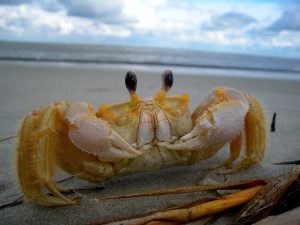
Ghost crab
The ghost crab got its name from its pale coloring as well as the fact that it is nocturnal and usually comes out to hunt at night. They feed on smaller crabs, insects, and sea turtle hatchlings, and are also scavengers. Ghost crabs lay their eggs in the water and need to keep their gills moist, which they can do by extracting moisture from the sand. However, they will drown if they are in the water for too long and you find them up on the beach or along the shorelines of estuaries rather than in the ocean itself.
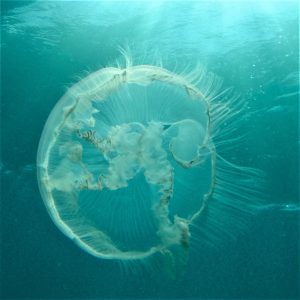
Moon jelly
If you see a moon jelly lit up with a nearby light source, whether in an aquarium or while swimming, you will see by this translucent/white jelly got its name! Thankfully this jellyfish has short tentacles that are easy to see and only pack a mild sting, so while you still do not want to brush up against one, they aren’t the stuff of nightmares. These translucent jellies are easily identified by the four horseshoe-shaped white sections on its bell, which are actually their gonads! Jellyfish can handle increased ocean temperatures (they actually mature and reproduce faster in warmer months!) and are more tolerant to pollution, high nutrient, and low oxygen conditions than most fish and other marine life that feed on jellyfish. As the populations of their predators decline and there are few organisms eating them, we can expect to see populations of jellyfish increase in the oceans in upcoming years.
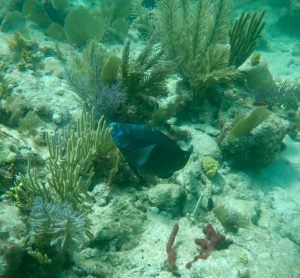
Midnight parrotfish
There are several species of parrotfish that live in south Florida, but the spookiest would have to be the midnight parrotfish. Okay, it isn’t really spooky, but is a beautiful mix of blue and black and is the darkest of the parrotfish species. Parrotfish have a “beak” that they use to feed on coral and algae that grows on coral and rocks. They are an important part of the ecosystem because their feeding behavior helps keep excess algae from growing over and competing with the corals in our reefs. Because they also eat small chunks of coral, they consume both the nutritious algae and the calcium carbonate skeleton. They cannot digest the calcium carbonate, so they excrete it… meaning that they produce sand poop! The next time you are on a beautiful white sandy beach near a coral reef, you can thank a parrotfish!
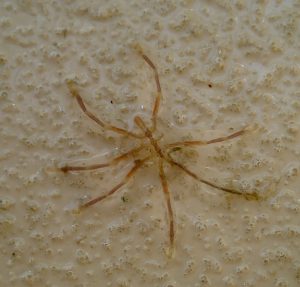
Sea spider
There are over 1,300 species of sea spiders, also called pycnogonids. These marine organisms are different from land spiders, which are arachnids. Both kinds of spiders are arthropods, but sea spiders are actually more closely related to horseshoe crabs than land spiders! Sea spiders are all about the legs – in addition to helping them walk along the seafloor, these long appendages provide a large surface area for oxygen to diffuse along, and some of their organs even extend down into their legs! Sea spiders feed by sucking the body fluids and guts of soft-bodied organisms such as worms, anemones, soft corals, and sponges (but not humans!). They are found all over the world and most are quite small, but giant sea spiders up to foot and a half long exist in the deep sea!
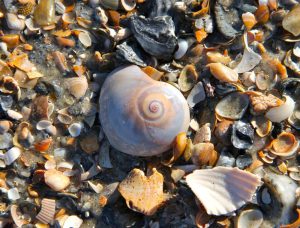
Moon snail
The moon snail is a type of gastropod and has a soft body that lives inside the hard shell it builds as it grows. These marine snails are voracious predators that feed on clams and other bivalves that live in the same intertidal zone of the beach. They use their radula (feeding structure) to bore a hole into the shell and then sucks out the tissues. If you find a shell on the beach with hole that has a beveled ledge to it, it was probably moon snail food! There are almost 200 species of moon snails around the world, but the most common species we have in Florida is also referred to as the shark eye due to the dark coloration they often have in the center swirl.
Other spooky creatures
The Halloween crab is a nocturnal land-crab that lives along mangroves, sand dunes, and the rainforest. It’s bright orange and purple coloration makes it especially festive for this time of year!
Goblin sharks live in the deep sea, but in 2014 a fisherman caught one 10 miles off the coast of Key West! This rare species has a large snout that protrudes above the mouth, giving it its name.
The vampire squid may not be fairly named, as it is neither a vampire nor a true squid. This cephalopod feeds pm dead organic material floating around in the water (no blood sucking for them). However, it does often have a red rust color – likely the reason for the name. Cool fact: instead of producing ink to escape predators, this deep-sea creature can emit a glowing, bioluminescent mucous!
 4
4
